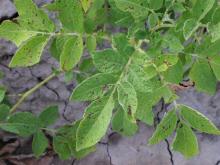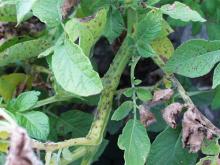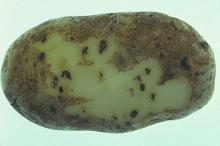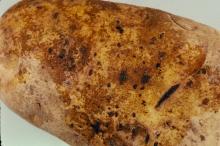By C. M. Ocamb and P. B. Hamm
See:
Potato (Solanum tuberosum) - Brown Spot and Black Pit
Cause Alternaria solani, a fungus that overwinters as viable mycelium and spores in infected crop residue. Heavy dews and frequent rains seem essential for severe outbreaks. The disease is found primarily under sprinkler irrigation. Reduced fertility often is associated with infection. Alternaria alternata can sometimes be found in leaf and stem spot outbreaks.
Symptoms First, oval or angular dark brown to black "target" spots appear on leaflets. There usually is a narrow chlorotic zone around the spot, which fades into the normal green. Lowest, oldest leaves are infected first, and they droop and dry as the disease progresses. If spots are numerous, they kill leaves and consequently may reduce yield.
Tuber infection is less frequent than leaf infection. Tuber lesions are sunken spots, brown to black, from 0.12 inch to 0.37 inch in diameter, and normally circular. The margin between diseased and healthy tubers is usually quite well defined. Underlying tissue shows a brown, corky, dry rot more than 0.12 inch deep.
Cultural control
- Rotate out of potatoes for 2 years.
- Sprinkler irrigation should allow foliage to dry rapidly after irrigation. Avoid irrigation in cool, cloudy periods. Also, avoid open lenticels by timing the end of irrigation.
- High soil fertility reduces disease severity.
- Harvest only when tubers are fully mature.
- Handle tubers carefully to avoid bruising.
- Rake and burn vines before harvest.
- Store tubers under conditions that promote rapid suberization.
Chemical control
Oregon-3 years of chemical-control experiments in Klamath Falls and central Oregon showed no increase in 'Russet Burbank' yield. Late-season infection due to reduced soil fertility and a changing environment more favorable for the fungus in the Columbia Basin can result in moderate to extensive infection in many varieties grown, and can cause yield reductions.
Idaho-research in eastern and southeastern Idaho indicates foliar sprays are effective when blight lesions appear above the lower third of the plant in nonperennial blight areas. In perennial areas, spray at 10- to 12-day intervals from mid-July to mid-August.
- Bordeaux 8-8-100 gives adequate control in the home garden if applied regularly. Frequent spraying stunts plants. H
- Carboxamide (Group 7) formulations are registered for use. Do not make more than two (2) sequential applications before alternating to a labeled fungicide with a different mode of action (non-Group 7).
- Endura at 2.5 to 4.5 oz/A on 7- to 14-day intervals. Preharvest interval is 10 days. 12-hr reentry.
- Fontelis (SLN OR-220004; SLN ID-220007; SLN WA-220003) at 10 to 24 fl oz/A on 7- to 14-day intervals. Preharvest interval is 7 days. 12-hr reentry.
- Vertisan at 14 to 24 fl oz/A on 7- to 14-day intervals. Preharvest interval is 7 days. 12-hr reentry.
- Chlorothalonil products (Group M5) such as:
- Bonide Fung-onil is available for home gardens. H
- Bravo Ultrex at 0.7 to 1.36 lb/A or Bravo Weather Stik at 0.75 to 1.5 pints/A on 7- to 10-day intervals. Preharvest interval is 7 days. 12-hr reentry.
- Echo 720 at 0.75 to 1.5 pints/A on 5- to 10-day intervals. Preharvest interval is 7 days. 12-hr reentry.
- Echo 90 DF at 0.625 to 1.25 lb/A on 5- to 10-day intervals. Preharvest interval is 7 days. 12-hr reentry.
- Ridomil Gold Bravo SC (Group 4 + M5) at 2.5 pints/A, no later than row closure. Do not use within 14 days of harvest. 48-hr reentry.
- Copper products (Group M1) are registered. Care must be taken to avoid build-up in the soil.
- Badge SC at 1 to 4 pints/A on 5-day intervals. Preharvest interval is 0 days. 48-hr reentry.
- Bonide Liquid Copper is available for home gardens. H
- Champ Formula 2 Flowable at 0.66 to 2.66 pints/A on 5- to 10-day intervals starting when the plants are 6-inches high. Suppresses Colorado potato beetle populations. 48-hr reentry.
- Cueva at 0.5 to 2 gal/100 gal water on 7- to 10-day intervals. May be applied on the day of harvest. 4-hr reentry. O
- Cuprofix Ultra 40 Disperss at 0.75 to 3 lb/A on 7- to 10-day intervals. 48-hr reentry.
- Kocide 2000 at 0.75 to 3 lb/A on 10- to 14-day intervals. 48-hr reentry.
- Liqui-Cop at 1.5 to 2 teaspoons/gal water. H
- Nu-Cop 50 WP at 1 to 5 lb/A on 5- to 10-day intervals. Do not apply within 14 days of harvest. 48-hr reentry. O
- Previsto at 1 to 3 quarts/A on 7- to 10-day intervals. 48-hr reentry. O
- Mancozeb products (Group M3) such as Dithane F-45 Rainshield, Gavel 75 DF or Ridomil Gold MZ (Group 4 + M3) ; see label for rates and intervals. Do not apply within 14 days of harvest. 24-hr reentry for Dithane F-45 Rainshield and 48-hr reentry for Gavel 75 DF and Ridomil Gold MZ.
- OSO 5% SC (Group 19) at 3.75 to 13 fl oz/A on 7- to 14-day intervals. Can be applied the day of harvest. 4-hr reentry O.
- Previcur Flex (Group 28) at no more than 1.2 pints/A on 7- to 10-day intervals in a tank-mixture with chlorothalonil or mancozeb. Also controls late blight. Do not apply within 14 days of harvest. 12-hr reentry.
- Provysol (Group 3) at 3 to 5 fl oz/A on 7- to 14-day intervals. Preharvest interval is 7 days. 12-hr reentry.
- Regalia (Group P5) at 1 to 4 quarts/A plus another fungicide on 7- to 10-day intervals is labeled for other leaf spot diseases in potato and can be used for early blight in Oregon. Does not benefit from the addition of an adjuvant. Preharvest interval is 0 days. 4-hr reentry. O
- Rovral 4 Flowable (Group 2) at 1 to 2 pints/A on 10- to 14-day intervals. Do not apply within 14 days of harvest. Do not irrigate for 24 hr after application. 24-hr reentry.
- Scala SC (Group 9) at 7 fl oz/A on 7- to 14-day intervals. Use only in a tank-mix with another effective early blight fungicide. Do not apply within 7 days of harvest. 12-hr reentry.
- Strobilurin fungicides (Group 11) are labeled for use. Do not make more than one (1) application of a Group 11 fungicide before alternating to a labeled fungicide with a different mode of action.
- Aftershock at 2 to 3.8 fl oz/A on 7- to 10- day intervals. Do not apply within 7 days of harvest. 12-hr reentry.
- Evito 480 SC at 3.8 fl oz/A on 7- to 10-day intervals. Preharvest interval is 7 days. 12-hr reentry.
- Headline at 6 to 9 fl oz/A prior to disease development on 7- to 14-day intervals. Preharvest interval is 3 days. 12-hr reentry.
- Quadris Flowable at 6 to 15.5 fl oz/A on 7- to 14-day intervals. Preharvest interval is 14 days. 4-hr reentry.
- Reason 500 SC at 5.5 to 8.2 fl oz/A on 5- to 10-day intervals. Do not apply within 14 days of harvest. 12-hr reentry.
- Super Tin 80 WP (Group 30) at 2.5 to 3.75 oz/A. Do not apply within 7 days of harvest. 48-hr reentry. Restricted-use pesticide.
- Trilogy at 0.5% to 1%. Not labeled for use in Oregon. Do not use above 90°F or when plants are under heat or moisture stress. Do not use when foliage is wet as good coverage is essential. Poor control as a stand-alone product. 4-hr reentry. O
- Vacres (potassium bicarbonate) at 2.5 to 5 lb/A on 7- to 14-day intervals. Preharvest interval is zero (0) days. 4-hr reentry.
Note: Premixes of fungicides are available and offer ease for fungicide resistance management. Do not make more than one (1) application of a Group 11 fungicide before alternating to a labeled fungicide with a different mode of action; for other fungicide groups apply no more than two (2) sequential applications alternating with another fungicide with a different mode of action.
- Amistar Top (Group 11 + 3) at 8 to 14 fl oz/A on a 7- to 14-day interval. Preharvest interval is 14 days. 12-hr reentry.
- Dexter Max (Group M3 + 11) at 1.6 to 2.1 lb/A on 5- to 10-day intervals. Preharvest interval is 14 days. 24-hr reentry.
- Distinguish 480 SC (Group 9 + 11) at 10 fl oz/A on 7- to 14-day intervals. Preharvest interval is 7 days. 12-hr reentry.
- Luna Tranquility (Group 7 + 9) at 8 to 12 fl oz/A on 7- to 14-day intervals. Do not make more than two (2) applications before alternating to a fungicide in different FRAC groups (non-Group 7 and non-Group 9). Preharvest interval is 7 days. 12-hr reentry.
- Miravis Prime (Group 7 + 12) at 9.2 to 11.4 fl oz/A on 7- to 14-day intervals. Preharvest interval is 14 days. 12-hr reentry.
- Orondis Opti (Group M5 + 49) at 1.75 to 2.5 pints/A on 5- to 14-day intervals. Preharvest interval is 14 days. 12-hr reentry.
- Quadris Opti (Group 11 + M5) at 1.6 pints/A or Quadris Top (Group 11 + 3) at 8 to 14 fl oz/A on 7- to 14-day intervals. Preharvest interval is 14 days. 12-hr reentry.
- Revus Top (Group 3 + 40) at 5.5 to 7 fl oz/A on 7- to 10-day intervals. Preharvest interval is 14 days. 12-hr reentry.
- Tanos (Group 11 + 27) at 6 to 8 oz/A on 7- to 10-day intervals. Must be tank-mixed with an appropriate fungicide with a different mode of action (non-Group 11 or 27), e.g. mancozeb, chlorothalonil, etc. Follow all tank-mix partner label restrictions and use at least minimum label rates of each. Do not apply within 14 days of harvest. 12-hr reentry.
- Veltyma (Group 3 + 11) at 5 to 10 fl oz/A on minimum interval of 14 days. Preharvest interval is 7 days. 12-hr reentry.
Note: Forecasting systems exist in Idaho to help time initial and subsequent applications.
Biological control Efficacy in the Pacific Northwest is unknown.
- Double Nickel LC at 1 to 6 quarts/A on 3- to 10-day intervals. Can be applied the day of harvest. 4-hr reentry. O
- Ecoswing at 1.5 to 2 pints/A is labeled for A. alternata. Preharvest interval is 0 days. 4-hr reentry. O
- LifeGard WG at 1 to 4.5 oz/100 gal on 7- to 14-day intervals for activating plant resistance. Apply in alternating, or tank-mix program, with compatible, labeled fungicides as part of a disease management program. Refer to label for appropriate rate per application volume. Preharvest interval is 0 days. 4-hr reentry. O
- Romeo at 0.45 to 0.68 lb/A on 7- to 10-day intervals starting prior to infection. Preharvest interval is 0 days. 4-hr reentry. O
- Serenade Opti at 14 to 20 oz/A on 7- to 10-day intervals Applications can be made up to harvest. Can rotate with other fungicides. 4-hr reentry. O
Reference Nolte, P., and Ojala, J. 1992. Control of Early Blight Disease of Potato. University of Idaho Current Information Series Publication 975.







